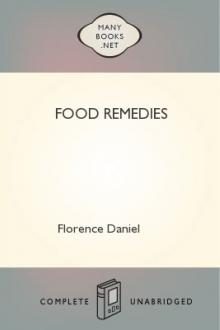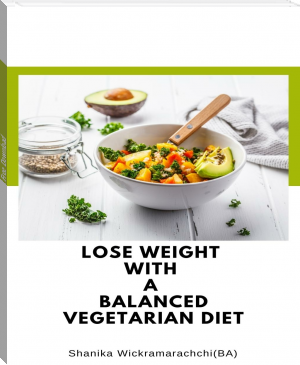The Chemistry of Food and Nutrition, A. W. Duncan [i love reading .txt] 📗

- Author: A. W. Duncan
- Performer: -
Book online «The Chemistry of Food and Nutrition, A. W. Duncan [i love reading .txt] 📗». Author A. W. Duncan
NOTES ON THE TABLE OF ANALYSIS.—Under calories are shown kilo-calories per pound of food. In the analysis marked U the crude fibre or cellulose is included with the carbo-hydrate, the figures being those given in Atwater's table. He has found that from 30 to 91 per cent. of the crude fibre was digested, according to the kind of food. The term fibre or cellulose in analytical tables is not a very definite one. It depends upon the details of the method of analysis. In the analyses other than U, the cellulose is excluded in calculating the calories. Nutrient ratio is the proportion of the sum of the carbo-hydrate and fat, compared with the proteid as 1. The fat has first been multiplied by 2.225 to bring it to the same nutrient value as the carbo-hydrate.
U indicates that the analyses are taken from the United States Department of Agriculture Experimental Station, Bulletin 28, the tests being chiefly made by Dr. W.O. Atwater, or under his direction. They are average analyses of several samples. The refuse consists of such parts as are rejected in preparing the food; the outer leaves, skin, stalk, seeds, &c., of vegetables; the shell of eggs; the bone, &c., of meat. E, indicates that the edible portion only of the food has been analysed, and under refuse, in brackets, is shown the quantity rejected before the analysis was made.
There is considerable variation in the same kind of food, according to the variety of seed and conditions of growth &c., especially is this the case with wheat and flour; whenever it has been possible the average of the analyses of many samples have been given. The method of analysis has not always been uniform, frequently the cellulose is included with the carbo-hydrates, and the proteid sometimes includes a very appreciable quantity of non-proteid nitrogenous matter. This is the case in the analysis of the mushrooms. G.—Analyses are by John Goodfellow; it will be noticed that the wheatmeal bread is not made from the same flour as the whole-meal. D.—B. Dyer, average of 19 fine and coarse oatmeals. S, from U.S. Cons. Reports, 1899. C.—A.H. Church. The walnut kernels are in the dried condition as purchased; originally of the same composition as shewn in the fresh kernels. C.D.—Cavendish or Figi variety of banana, analysis by D.W.M. Doherty, N.S. Wales. P.—A. Petermann, U.S. Cons. Banana flour, musca paradisiaca variety. This is widely used in Central America. The flour is from the unripe fruit, and contains starch 45.7 per cent.; on ripening the starch is converted into sugar. K.—Konig, mean of 90 analysis. Milk:—Average of many thousand analyses of the pure. Butter.—Made without salt. L, from the "Lancet," 1903, I, p. 72. Oysters at 2/6 per dozen. The 8.09 per cent. includes 0.91 glycogen (animal starch). The shell was of course excluded, also the liquid in the shell. Apples.—The refuse includes seeds, skin, &c., and such edible portion as is wasted in cutting them away; the analysis was made on the rest.
Cookery.—Flesh is easier to digest raw. A few, on the advice of their doctors, eat minced raw flesh, raw beef juice and even fresh warm blood. Such practice is abhorrent to every person of refinement. Cooking lessens the offensive appearance and qualities of flesh and changes the flavour; thorough cooking also destroys any parasites that may be present. Raw flesh is more stimulating to the animal passions, and excites ferocity in both man and animals. If the old argument was valid, that as flesh is much nearer in composition and quality to our own flesh and tissues, it is therefore our best food, we do wrong in coagulating the albuminoids, hardening the muscle substance and scorching it by cooking.
Fruits when ripe and in good condition are best eaten raw; cooking spoils the flavour. Food requiring mastication and encouraging insalivation is the best. Food is frequently made too sloppy or liquid, and is eaten too hot, thus favouring indigestion and decay of the teeth. The cereals and pulses can only with difficulty be eaten raw. When cooked in water the starch granules swell and break up, the plant cells are ruptured, the fibres are separated and the nutritious matter rendered easy of digestion. The flavour is greatly improved. Cooking increases our range and variety of food. The civilised races use it to excess and over-season their dishes, favouring over-eating.
If baking powders are used they should only be of the best makes. They should be composed of sodium bicarbonate and tartaric acid, in such correct proportions that upon the addition of water only sodium tartrate and carbon dioxide (carbonic acid) should result. Some powders contain an excess of sodium bicarbonate. Self-raising flours should be avoided. They are commonly composed of—in addition to sodium bicarbonate—acid calcium phosphate, calcium superphosphate and calcium sulphate. Common baking powders often consist of the same ingredients, and sometimes also of magnesia and alum. These are often made and sold by ignorant men, whose sole object is to make money. Calcium superphosphate and acid calcium phosphate very frequently contain arsenic, and as the cheap commercial qualities are often used there is danger in this direction. A good formula for baking powder is, tartaric acid 8 ozs., sodium bicarbonate 9 ozs., rice flour 10 to 20 ozs. The last is added to baking powders to improve the keeping quality and to add bulk. The ingredients must be first carefully dried, the sodium bicarbonate at not too high a temperature or it decomposes, and then thoroughly mixed; this must be preserved in well closed and dry bottles. Another formula, which is slow rising and well adapted for pastry, is sodium bicarbonate 4 ozs., cream of tartar 9 ozs., rice flour about 14 ozs. Custard powders consist of starch, colouring and flavouring. Egg powders are similar to baking powders but contain yellow colouring. Little objection can be taken to them if they are coloured with saffron; turmeric would do if it were not that it gives a slightly unpleasant taste. Artificial colouring matters or coal tar derivatives are much used, several of these are distinctly poisonous.
Drinks.—It is better not to drink during eating, or insalivation may be interfered with; a drink is better taken at the end of a meal. The practice of washing down food with hot tea is bad. The refreshing nature of a cup of hot tea, coffee, or cocoa is to a very great extent due to the warmth of the water. The benefit is felt at once, before the alkaloid can enter the blood stream and stimulate the nerve centres. Hot water, not too hot to cause congestion of the mucous membrane, is one of the best drinks. When the purity of the water supply is doubtful, there is advantage in first bringing it to the boil, as pathogenic bacteria are destroyed. Some find it beneficial to drink a cup of hot water the first thing in the morning; this cleanses the stomach from any accumulation of mucus.
If fruit, succulent vegetables, or cooked food, containing much water be freely used, and there be little perspiration, it is possible to do without drinking; but there is danger of taking insufficient water to hold freely in solution the waste products excreted by the body.
Aerated drinks, except a very few of the best, and non-alcoholic beers and wines, are generally unwholesome, from their containing preservatives, foaming powders, artificial flavourings, &c.
Stimulants.—Tea and coffee contain an alkaloid theine, besides volatile oils, tannin, &c. Cocoa contains the milder alkaloid, theobromine. They stimulate the heart and nervous systems; tea and coffee have also a diuretic effect. Formerly they were erroneously thought to lessen tissue waste. These alkaloids, being purins, are open to the general objections named elsewhere. Stimulants do not impart energy or force of any kind, but only call forth reserve strength by exciting the heart, nervous system, &c., to increased activity. This is followed by a depression which is as great, generally greater, than the previous stimulation. Except, perhaps, as an occasional medicine, stimulants, should be avoided. Analysis of cocoa shows a good proportion of proteids and a very large quantity of fat. The claim that it is a valuable and nutritious food would only be true if it could be eaten in such quantities as are other foods (bread, fruits, &c.). Were this attempted, poisoning would result from the large quantity of alkaloid. The food value of half a spoonful or thereabouts of cocoa is insignificant. Certain much advertised cocoa mixtures are ridiculous in their pretentions, unscientific in preparation, and often injurious.
Cereals.—The most valuable is wheat, from its proteid being chiefly in the form known as gluten. From its tenacity, gluten enables a much better loaf to be produced from wheat than from any other cereal. The outer part of the grain is the richest in mineral matter and proteid. Wheatmeal bread shows a considerably higher proteid value than white. A large proportion of the proteid in the outer coats of the wheat berry is, however, not digested, and in some experiments the waste has been enough to quite nullify its seeming advantage over white bread. Coarsely ground, sharp branny particles in bread irritate the intestines, and cause excessive waste of nutriment; but finely ground wheatmeal is free from this objection, and is beneficial in preventing constipation. The comparative value of white and brown bread has been much discussed; it depends both on the quality of the bread and the condition of the digestive organs. Experiments on the digestion of bread and other things, have often been made on persons unaccustomed to such foods, or the foods have been given in excessive quantity. To those accustomed to it good wheatmeal bread is much pleasanter, more satisfying, and better flavoured than white; indeed, the latter is described as insipid. Most bakers' bread is of unsatisfactory quality. Flour and bread contain very little fat, the absence of which is considered a defect. This is remedied by the addition of butter, fat or oil, or by nuts, &c., which are rich in oil. These may be mixed with the flour prior to cooking, or used afterwards.
Oats contain a substance called avenin, apparently an alkaloid, which has an irritating action; the quantity is variable. It is to this that the so-called heating effect of oatmeal on some persons is due.
Prepared Cereals or Breakfast Foods.—Analyses were made of 34 of these cereal preparations by Weems and Ellis (Iowa State College Agricultural Bulletin, 1904). They report that the foods possess no nutritive value in excess of ordinary food materials; that the claim made for many pre-digested foods are valueless, and no reliance can be placed on the statement that they are remedies for any disease.
Oatmeal and other cereals are sold in packets as being partially cooked. We do not doubt that they have been subjected to a dry heat, but this has scarcely any effect on their starch and other constituents. The difference is a mechanical one. In rolled oats the grains are so cracked and broken, that on boiling with water, the water readily penetrates and more quickly cooks them throughout. There are other prepared cereal foods, but we doubt whether they are thoroughly cooked after the short boiling directed on the labels. They are a great convenience where it is difficult to get





Comments (0)